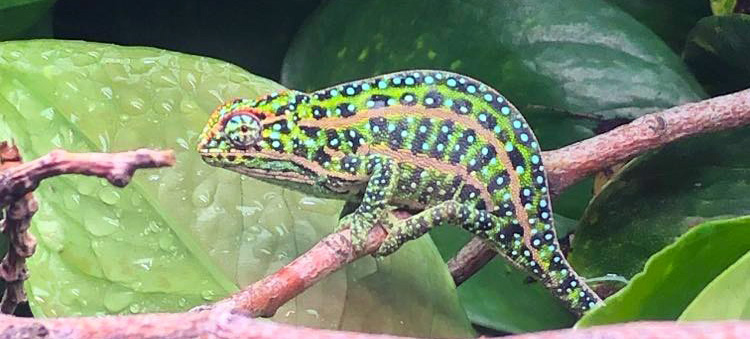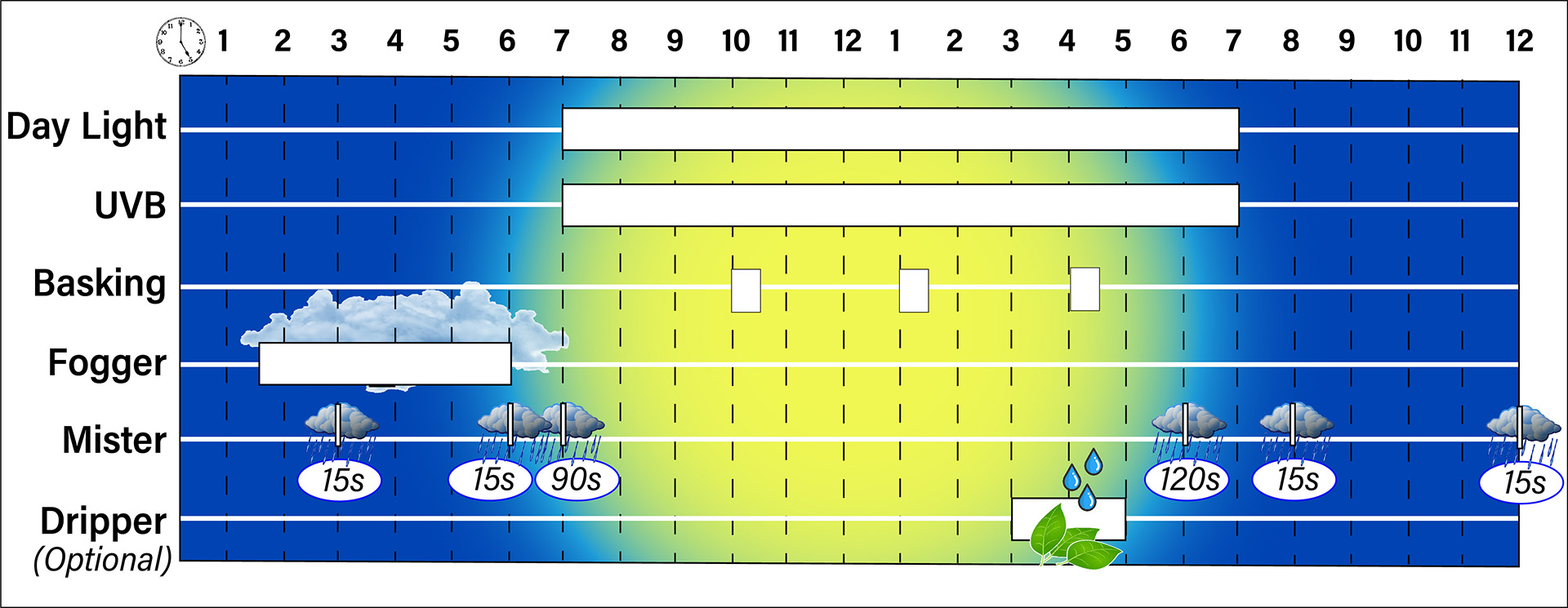Image courtesy of Michael Nash
Introduction to Furcifer campani, the Jeweled Chameleon
Furcifer campani, commonly know as the Jeweled Chameleon, is a small, brightly colored chameleon from the central highlands in Madagascar at elevations from around 1800 to 2600m by the IUCN Redlist. They experience wide temperature extremes and are a good candidate for establishing a captive population.
They have the advantage that they are smaller in size and get to about 5”-7” in length including tail. They also have smaller clutches of eggs than the more common panther chameleon and so babies are easier to manage.
The disadvantage to this species is that the eggs appear to need a diapause so this requires a cooling incubator. The babies also hatch very small. So the size advantage has another side to the coin! But these disadvantages are resolved by getting the proper set-up and equipment which, if done right the first time, then leads to a relatively smooth breeding project for the coming years. If breeding is not the object and simple enjoyment of a colorful species is your goal then you have a prime candidate in a Jeweled chameleon.
The Breeding Community

Image courtesy of Michael Nash
A valid question would be why have they not been bred before. The answer is that we, as a community, are working through figuring out these mini-chameleons. Much work has been done with the Carpet Chameleon (Furcifer lateralis) with great success and now attention is being turned to the lesser known Jeweled Chameleon. Add to that, any chameleon which requires a diapause automatically moves into the realm of advanced keepers who invest in a cooling incubator. This is being balanced by a growing number of serious keepers aspiring to be breeders not taking the easy road because they are looking to be on the ground floor of establishing other species. There has been more and more awareness that, without the diversification of attention by serious breeders to species other than panthers, we may be left with only panthers and Veileds in the not so distant future.
Jeweled Chameleon Pet Potential

Image courtesy of Michael Nash
For those interested in Jeweled Chameleons as a pet, the #1 rule is to buy captive hatched babies. These have been essentially non-existent which is why this species has taken so long to get the dedicated attention needed. Wild caught specimens come in having lived much of their lives or with parasites and other conditions that require an experienced hand to work through. Thus, leave the wild caught imports to the breeders who know how to care for them and need them to diversify the bloodlines. Captive hatched babies should start to become available in the second half of 2022. As the breeding community needs people willing to take single chameleons, if you only want to keep one, please consider being part of the community for this species. Join the Furcifer Campani Facebook community to get the latest in availability information. WARNING: Do NOT ask price on the Facebook group. Any mention or hint of sales of animals and Facebook can (and has) shut down the account without warning or recourse! So, when clutches are announced or hatched babies are posted, go to private messenger of the person posting the babies to inquire the following “I would like more information about becoming a Jeweled Chameleon keeper. What would my next steps be?” And then you will be given directions for taking the next steps off of the Facebook platform.
Jeweled Chameleon Care Summary
The Jeweled Chameleon Care Summary distills the most important aspects of husbandry care into an easily referenced handout. But chameleon care is, unfortunately, much more involved than can be presented on a summary sheet. Therefore, you may use this sheet as a reference and return to this page where we will go over each and every aspect that is on the summary sheet in detail.
The Jeweled Chameleon Lifecycle

Images courtesy of Michael Nash
Cage Type, Size, and Set-up
Minimum cage size:
16″ x 16″ x 20″
Ideal cage size:
36″ x 18″ x 36″, 2′ x 2′ x 4′, or Greater
Cage Size.The Jeweled Chameleon is a small chameleon and can be comfortably housed in smaller cages. A 16” x 16” x 20” is the minimum recommended for a single adult. But extra attention needs to be given to creating the temperature and humidity requirements. The smaller the cage the harder it is to give a range of gradients that the chameleon can use to take care of themselves. Thus, I would suggest to only try the minimum size if you are experienced In creating chameleon environments. A 16”x16”x20” cage is sufficient when set-up effectively. I would suggest leaving the minimum size to the experienced breeders and take advantage of the Jeweled Chameleon’s small size to provide a spacious environment. A 22” x 17” x 24”H cage is much more easily managed and effective gradients can easily be created in those dimensions. But for maximum enjoyment, make a hybrid cage out of the commonly found 36” x 18” x 36” Exo-Terra or else the common 24x24x48 or even bigger! The larger the environment you create the easier it is for your chameleon to find the microclimates they need to live their best life. If you are not a breeder, then I encourage you to go overboard and get the largest size possible. Do not let the size of Furcifer campani limit the cage size you get for them!
One chameleon per cage
One Chameleon per Cage. A time tested rule for chameleons is to house one per cage. It is human of us to want to pair things up or think of friendship, but chameleons are different. They have no concept of family or community in the way we think of it. Over the decades, newcomers test this over and over and the results always return back to one chameleon per cage. If you would like to dive deeper into the details of cohabitation and why it does not work in captivity (when they can be found around each other in the wild) then you may listen to these dynamics on this podcast episode: Ep 107 Keeping Chameleons Together
Screen, hybrid, or glass cages can be used depending on how much environmental control is needed
Cage Type.
The cage type (screen, hybrid, glass) depends on your environment. Take a look at the temperature and humidity requirements. How different are they from what the ambient conditions are in the room where the cage will be put? The further away from ideal you are, the more solid sides you will need on the cage. Combine that with the overwhelming success that keepers and breeders have had with bioactive hybrid cages that use the chimney effect for ventilation and a hybrid cage is the cage type that I suggest as a default choice.
A hybrid cage is one that has solid sides, back, and main door, with a screen top and some screen vents in the front that allow cool air to come in the bottom and rise to escape up top as warm air. There has been an explosion of caging companies offering hybrid caging and since we are now talking about sizes appropriate for geckos, the caging market is actually quite mature!
That said, if you have old screen cages lying around that you would like to use then simply block off the sides and back using coroplast panels or even shrink-fit window insulation.
Successful breeding and raising of babies has come using cages set up to be bioactive. This matches perfectly with the natural environment where the babies will stay low in the grasses where there are more plentiful insects and more protective cover.
You can start looking into hybrid cages with this podcast episode: Keeping Chameleons in Hybrid Cages
Ventilation.
It is important that there is air flow in the cage. But this means simply an exchange of air so the cage does not get stagnant. There is a common misconception that the cage needs to be all screen to get proper ventilation. In reality, an all-screen cage is usually too much ventilation and your ability to raise humidity is severely limited.
With the increasing use of hybrid cages the community must develop the skill of ensuring that there is the minimum ventilation. Once again, small vents at the bottom front and a screen top provide enough that there is a healthy air exchange.
You can test whether you have effective air exchange by how fast it takes for water misted onto the leaves to evaporate. There is no hard and fast rule. There just has to be moisture evaporating relatively soon afterwards.
Cage Interior
The cage should be densely planted to provide many hiding places for your chameleon. The top six inches can be only sticks to provide easy basking with the heat bulb and soaking up UVB from the UVB light. But below that needs to be an area where they are able to feel secure and get away from the heat and UVB.
Michael Nash uses a variety of grasses for his bio-active environments and the Jeweled chameleons thrive with this.
MUST have suitable perching area behind plants where chameleon can hide entire body from view and block UVB light from above
Security. This is the most missed element of chameleon cage set-up. Your chameleon needs a feeling of security. They get this by having a dense plant layer in the middle of their cage. This leaf layer will need to be sufficient for them to perch with the majority of their body hidden away from view and it also must be dense enough to block the UVB from the UVB bulb above.
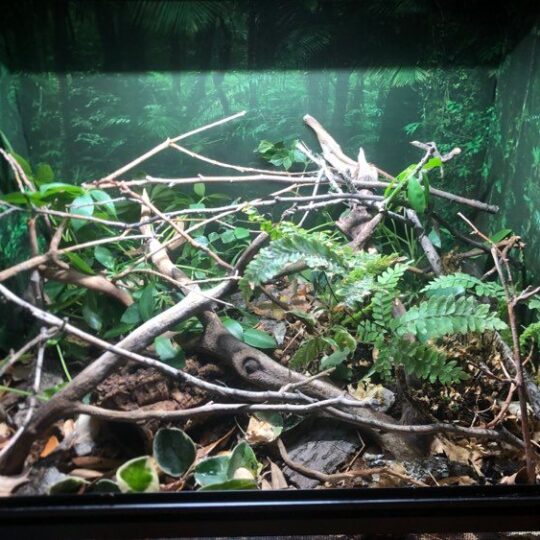
Bio-active, hybrid cages have been proven effective to raise and house Jeweled Chameleons (Image courtesy of Michael Nash)
Ambient Temperature
Summer:
Daytime: 75 – 79°F / 24-26°C
Nighttime: 61 – 64°F / 16 – 18°C
Wintre:
Daytime: 70°F / 21°C
Nighttime: 50°F / 10°C
Ambient temperature is what most of the cage will read. If you have a screen cage this reading will be suspiciously similar to your room conditions. The basking bulb creates a warm microclimate that will dissipate in a relatively short distance.
The Jeweled Chameleon comes from the highlands and so they will be expecting cool temperatures and cold nights. The dry season is harsh to the Jeweled Chameleons and, according to eye witnesses, they essentially disappear (Euan Edwards, Season 2 Episode 15 Chameleon Academy Podcast “What Do Chameleon Do During the Dry Season”). Whether they die out or bury themselves to wait for the next wet season remains to be seen. But there is value in providing a winter cool down of lower temperatures. Thus, on the care summary you will see winter and summer temperature levels. Note: If you live in the Northern hemisphere remember that your natural winter and summer are reversed from Madagascar and so a wild caught chameleon must be slowly acclimated to the reversed seasons. Captive hatched, of course, would not need this acclimation.
In the summer we strive for an ambient temperature in the high 70s with a night time drop to the low 60s. Like all the higher elevation species we work with, the nighttime drop is an important part of their health. It promotes deep sleep. They are ectothermic (cold blooded) so will not fall into hypothermia as we humans would. Nighttime temperatures into the 50s or 40s would not be a health issue (and would actually be a deeper, more restful, sleep) as long as they were given the opportunity to warm up once the lights come on. Thus, do not use heat lamps (red or otherwise), ceramic heat emitters, or any other heat source unless the temperature goes to freezing. Even though the area they come from can dip to the freezing level, I do not understand their behaviors and protective actions enough to feel comfortable suggesting that we should replicate going that low. Perhaps we will figure this out later. But, of course, if there is no benefit to night time temperatures below 40, there is no reason to replicate them. Nature always gives us a mix of medicine and poison in the same bottle and those of us teasing out husbandry requirements must be careful to know where that line is.
Basking Temperature
Basking Temperature: 80-86°F /27-30°C
Adults and babies have been raised under basking temperatures of low to mid 80s. Though this has been provided in a non-standard schedule so please consult the lighting/hydration 24 hour timeline graphic. Extra special attention needs to applied to providing a basking light if you are using a small cage. Heat bulbs can easily overpower a small cage. So, use smaller wattage bulbs, mount them a few inches away from the cage top, or both. You can use a thermometer to be your guide as to what you have to do. Resting the heat bulb directly on the cage top is usually a bad idea because the areas directly beneath the bulb, where a chameleon can climb upside own, will have excessive heat that can burn. Chameleons have, traditionally, been oblivious to when their own body is burning in the heat so we must take responsibility to ensure that any area they can conceivably reach has a safe temperature of the mid-80s F at most.
Humidity
Daytime: 40-50% RH
Nighttime: 80 – 100% RH
The Jeweled Chameleon will accept the standard naturalistic approach to humidity of upwards to 100% RH at night and then down to a level during the day that allows the surfaces of the cage and branches to dry out. The humidity numbers on the care summary of 40-50% give a magnitude that is likely to give you dry surfaces during the day without overly dehydrating the chameleon. And, this is where the numbers on the care sheet comes from. Humidity is part of the overall environment. The higher the humidity the less dehydrated the chameleon gets, but the more suitable for bacteria, fungal, and mold growth. The drier the climate the more the bacteria, fungal, and mold growth is inhibited, but the more the chameleon will dehydrate. Thus, the humidity cycle over 24 hours will be up to 100% during the cool night where we can hydrate our chameleon and the coolness slows bacteria growth. During the day when the heat and moisture would combine to make for a perfect bacteria growth environment, we take the humidity down just enough that the surfaces dry out. This is important because constantly wet surfaces will encourage bacterial/fungal/mold growth and produce sores on the feet of your chameleon. So, the drop in humidity during the day is less for the chameleon’s personal needs and more for the health of the overall environment that the chameleon depends on. With this 24 hour cycle repeated every day the chameleon stays hydrated while the cage environment stays healthy.
UVB

Michael Nash reports that UVI 3 at the basking branch is effective in producing fully calcified eggs. He also reports that they seem to have tolerated UV levels up to UVI 7. Thus, the standard Chameleon Academy UVB baseline of UVI 3 at the basking branch and UVI 6 as the maximum that is allowed at the cage top (which is where your chameleon can expose its sensitive underbelly to the lights) can be used.
UVB is another energy source that we must be extra careful about when working with a smaller cage. Especially since UVB is invisible to us, It would be easy to provide too much UVB and not immediately know it. And, on the other side, we would not be able to tell, just by looking at the bulb, that it is an old an ineffective bulb. The only way to truly know your UVB level is to use a UVB meter. UVB is in the same situation as the heat bulb. You will want to be careful that your chameleon has ample options to escape the UVB.
Setting up the lighting and hydration schedule
When we set up our daily schedule we are attempting to replicate the wild conditions that the chameleon has grown to expect. Let’s start at midnight.
At midnight the chameleon has been asleep for many hours. It is dark and, although the moon waxes and wanes, chameleons will seek out dark places to sleep. They see light of all colors just fine and any light can disturb their rest. This includes red light and other lights designed for reptiles. These lights do not fool chameleons. They recognize them as lights and it will disturb the chameleon’s sleep. Do not use any light at night.
As the early morning progresses the humidity rises. Fog banks can start to form and the chameleon is breathing in moist air. Pictures from Yemen show thick clouds obscuring the valleys, or “wadis”, that the Veiled Chameleons live in. This high humidity forms an important part in their natural hydration. To simulate this, we turn ultrasonic humidifiers on around 1- 2AM. The fog from the humidifiers tends to bounce off of surfaces and roll out the cage so we run the misting system for a a minute to coat the cage in a layer of water. This helps the fogger be more effective and the fog tends to stick around. The fogger is left on until just before the lights come on so the chameleon can breathe in all that humidity. Just before the lights come on the misters are run for another couple of minute to make sure that the chameleon wakes up to surfaces covered in “dew”. This is a natural source of water for them even in their dry season. Once the dew is laid down the lights can come on.
Around 7AM the daylights come on. This can include the UVB light if they are the same fixture. If they are separate fixtures then save turning the UVB light on to correspond to when the basking bulb is switched on. I like to leave the daylight bulbs on for 15 or so minutes to give the chameleon a chance to leisurely lick whatever dew they want. I then turn the basking bulb on so they can warm themselves up.
As the ambient temperatures start to warm there is no longer the need for a basking lamp and it is shut off. The actual time that the basking lamp is on will depend on your chameleon’s needs. Watch the behavior. If the routinely get the warmth they need in 30 minutes and then climb away with content colors to hunt then reduce your basking time to that time that they make use of the warmth. If they need the warmth for a longer period of time then leave the basking bulb on longer. Watch your chameleon and they will tell you what they need. With a screen cage there is usually no issue leaving it on for the day, but if your ambient daytime temperatures start getting to the high end of their comfort, you should shut the basking lamp off. In solid walled enclosures, heat may be retained and you will be able to shut the basking bulb off sooner. On my chart I am limiting the basking lamp to a couple hours. Considering the epidemic of over energized veiled chameleons I think it wise to use two hours as a default and continue heating after that only if there is a specific reason to do so.
Sometime during the day start your dripper. This is a backup hydration strategy just to make sure they have enough water. While it is true they do not have drippers every day in the wild during the dry season, they also are not needing to reconstitute dry calcium powder on all their feeders. The advantage of running a dripper is that it is completely optional for them and, as a bonus, it also allows you the opportunity to ensure your plants get watered. Place it above a different plant each day and through out the week, all plants will get watered. It is not critical when you start the dripper. In this schedule I have it in the late afternoon so that the chameleon can rehydrate before the evening rest. I suggest starting the dripper an hour or so after feeding them so they can replenish what they need. In the wild, their food is a source of hydration.
Once the chameleon settles in and goes to sleep I like to have a couple minutes misting just to set up the night humidity.
You’ll notice there are no daytime mistings. Although this is common in chameleon husbandry I am transitioning my mistings to the sleep hours. Chameleons have been consistent in their communicating that they do not like being sprayed. I have given up deciding I know what is best for them and started to listen to them. The morning dew and the afternoon dripper provide the necessary hydration in a natural way. With those provided there just isn’t a need to force them into a shower in the middle of the day.
Feeding

Although there are reports of Jeweled Chameleons taking down some surprisingly large prey. But, in captivity, we have no need to risk choking. Use feeder insects that are about one feeder unit where a single insect feeder unit is equal to the volume of a cricket that is the length between the eyes of the chameleon. Obviously, this can be variable, but it gives a safe magnitude. This means that, for example, if one feeder unit is a ½” cricket then that is equal to four ¼” crickets or 20 fruit flies or one ¾” or even 1” superworm. The Jeweled Chameleon has a small head and so be mindful of the size prey that you offer so it does not hurt your chameleon by fighting back or choke them by being too big to swallow.
Furcifer campani can be prone to obesity and so the recommendation is to feed adults 3-4 feeder units every other day. As obesity is life threatening , especially to females that can get egg bound, it is important to not overfeed. For gravid females it is reasonable to increase their food intake to 4-5 feeder units.
Growing babies though, can be fed as much as they will eat
Michael Nash shares his adult feeding schedule
“A typical feeding schedule I use is as follows. Day 1: 2-3 ½” crickets, Day 2: nothing, Day 3: nothing, Day 4: 15-20 fruit flies (maybe 30), Day 5: nothing, Day 6: 4-5 black soldier flies, Day 7: nothing.”
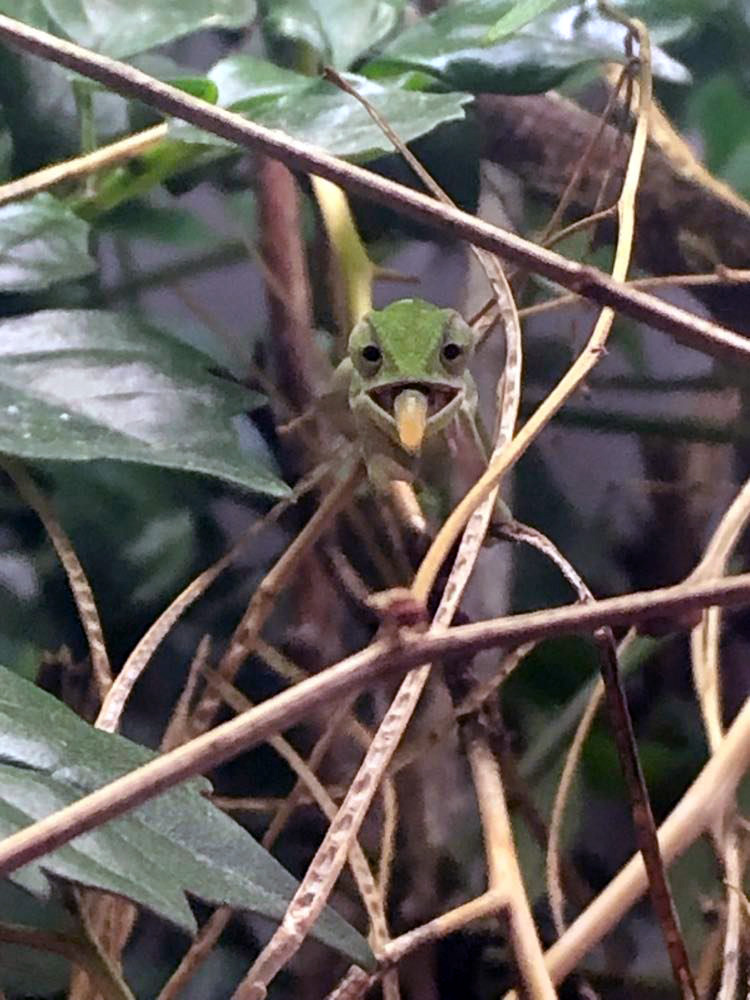
Image courtesy of Michael Nash
Supplementation
Introduction to Supplementation
We follow the standard schedule of dusting with calcium every feeding and adding a multivitamin with Vitamin A and D3 of, at most, 100k IUs/lb of vitamin A every two weeks. This has been effective and so there is little motivation to figure out at what point Furcifer campani will develop the internal imbalance that shows itself as edema.
| Manuf | Name | Vit D3 | Vit A | Mg | Ca:P | Carotenoids |
|---|---|---|---|---|---|---|
| Arcadia | RevitaliseD3 | 2.3k IU/lb | 23k IU/lb | 8% | No | Multi |
| Repashy | Calcium Plus LoD | 8k IU/lb | 80k IU/lb | No | No | Multi |
| Zoo Med | Reptivite w/ D3 | 10k IU/lb | 100k IU/lb | 2.7k mg/kg | 2:1 | No |
| Repashy | Calcium Plus | 20k IU/lb | 200k IU/lb | No | No | Multi |

A nutrition regimen consisting of a calcium supplement with no vitamin D3, a multivitamin with both vitamin A and D3, a UV Index of 3, and richly gutloaded feeder insects will provide nutrition for a chameleon over each of its life stages.
Breeding Jeweled Chameleons
This is an egg laying species.
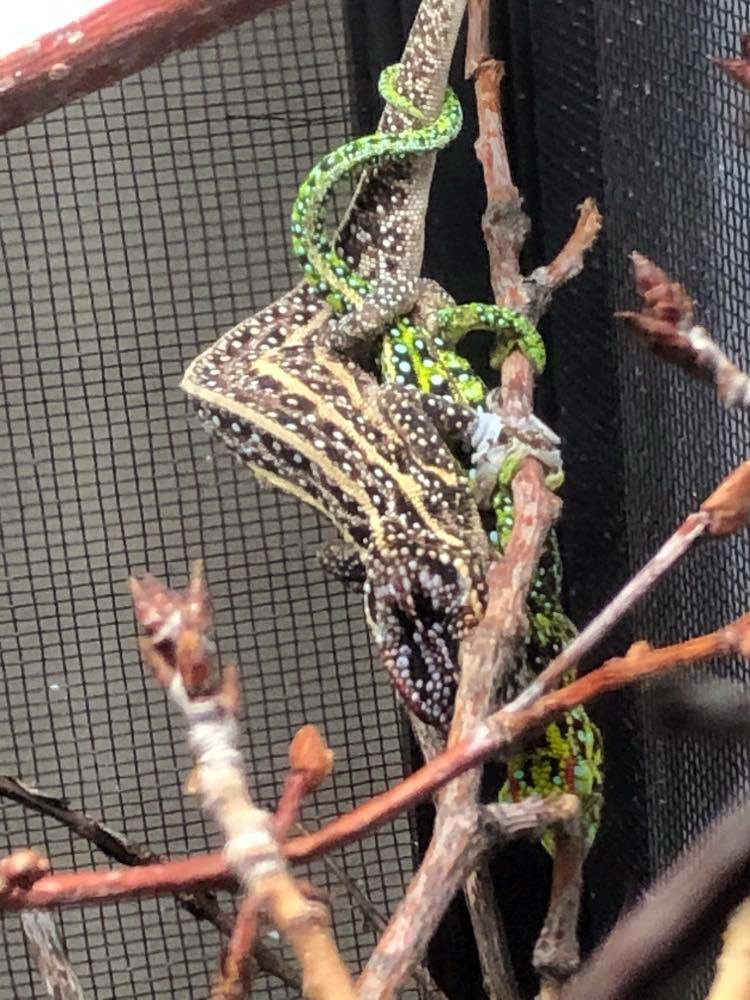
Image courtesy of Michael Nash
Jeweled Chameleon Baby Care
Jeweled Chameleon babies are small and require small food
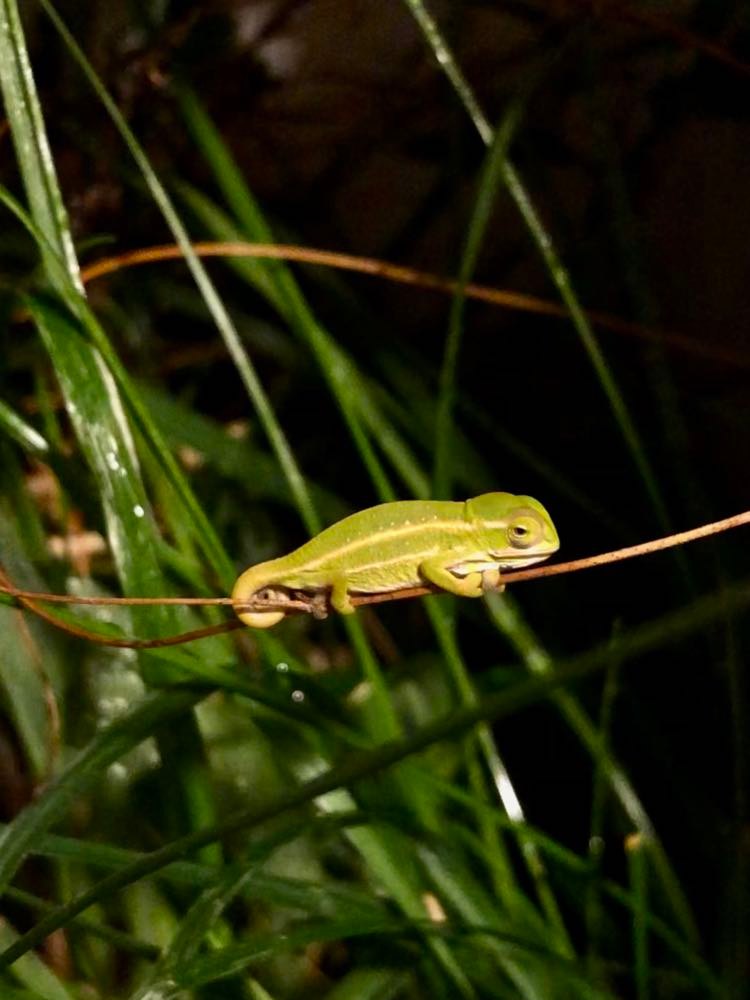
Image courtesy of Michael Nash

